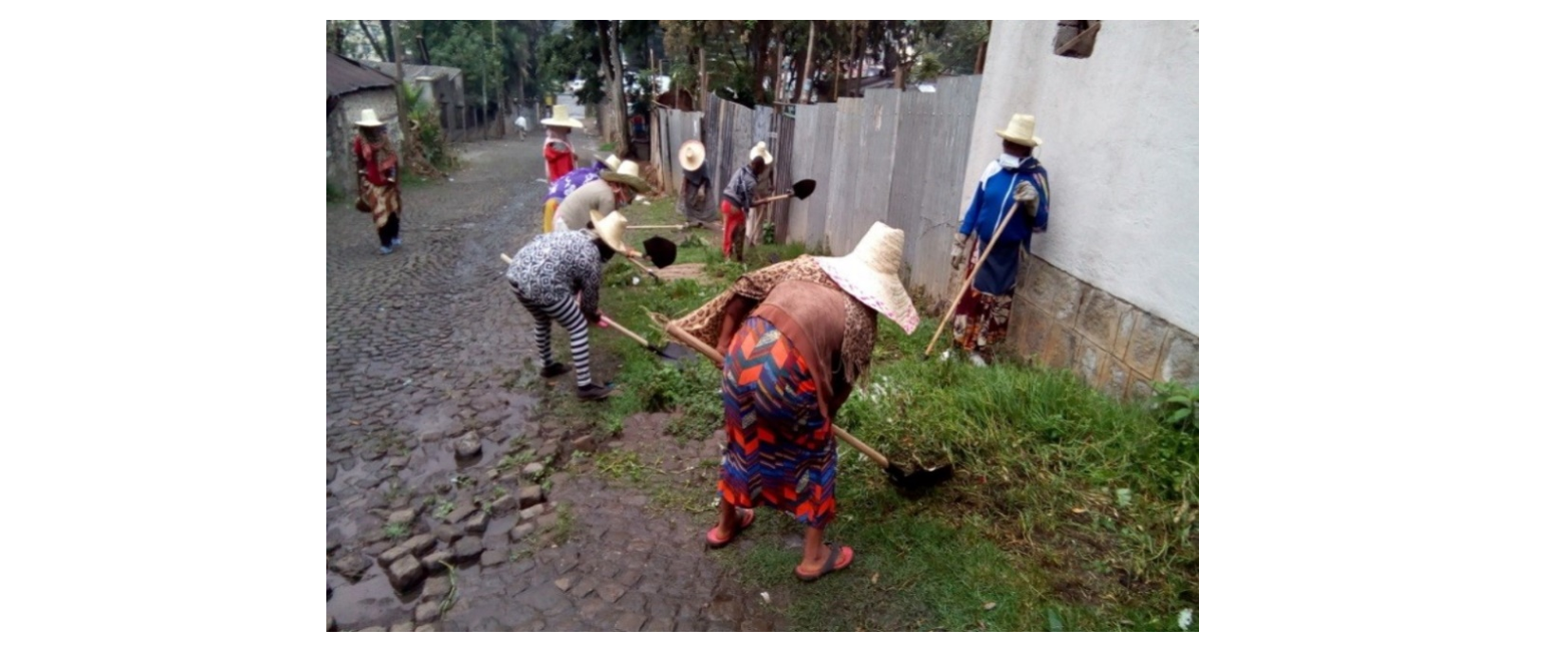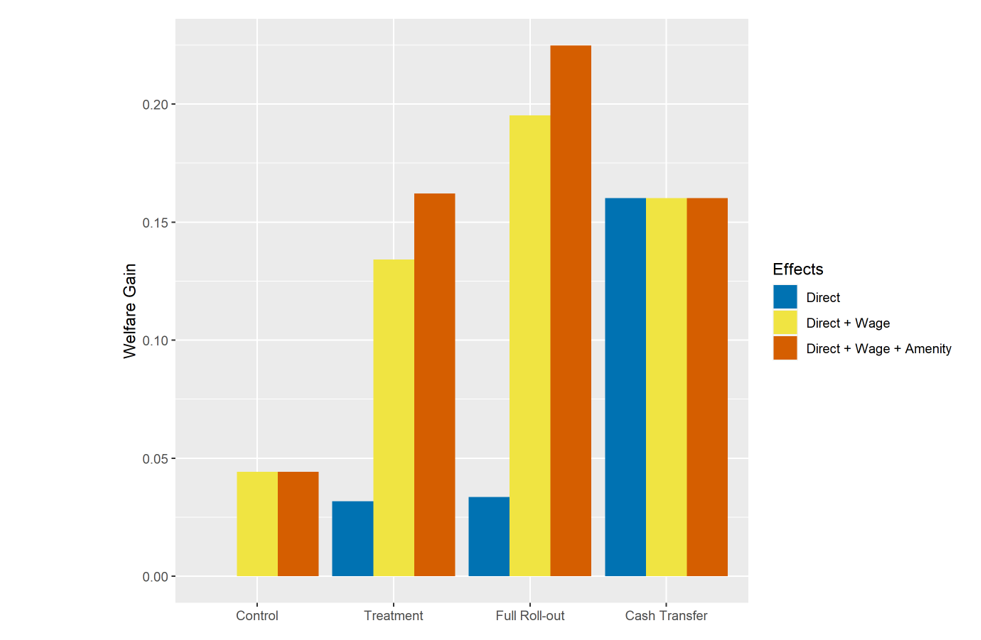
A public works programme in Ethiopia improves welfare for the urban poor both directly for participants and indirectly through increasing private sector wages and improving amenities
A majority of the population in low and middle-income countries now resides in urban areas. This urbanisation, despite lower urban poverty levels compared to rural areas, has led to a surge of rural poor into cities. As a result, the urban poor are growing faster than the overall population (Ravallion et al. 2009). Thus, poverty reduction strategies designed for rural areas must adapt to urban contexts (Gentilini 2015). For example, Ethiopia, after 13 years of its rural public works programme (PSNP), launched its urban counterpart, the UPSNP (Urban Productive Safety Nets Program), in 2018. However, there is a notable gap in research on urban versus rural anti-poverty strategies.
Our research (Franklin, Imbert, Abebe and Mejia-Mantilla 2023) evaluates the UPSNP. This programme offers up to 240 days of local employment per year to poor households selected by their community, for tasks like street cleaning and greening public spaces. A rigorous evaluation is made possible by the random selection of neighbourhoods in Addis Ababa for the first year of the programme.
Reasons anti-poverty programmes could have different effects in urban compared to rural areas
Cities have higher rates of wage labour participation and less seasonality in labour demand than rural areas. Urban households may join public works at the expense of private sector work, thereby reducing income gains from participating in the programme. Additionally, if public works crowd out labour supply to the private sector, private sector wages may go up (Imbert and Papp 2015). The rise in wages could have more negative effects on private sector employment in urban labour markets, which are likely more competitive than rural labour markets, where employers often have market power (Muralidharan et al. 2023). Methodologically, estimating these effects is challenging due to cities' interconnectedness via transport, causing local labour market effects to spill over across neighbourhoods in ways that are not only based on geographical proximity.
Figure 1: Public works activities in Addis Ababa

The activities performed under public works programmes also differ in urban contexts. Unlike rural areas where they tend to support agricultural infrastructure, the UPSNP focuses on improving neighbourhood amenities, which are hard to value quantitatively.
The benefits of UPSNP: direct benefits, rising private wages, and improved amenities
(i) Direct benefit from public works participation:
Nearly all households eligible for the programme participated and utilised their full employment entitlement, indicating significant direct benefits. These benefits arise from the fact that public works jobs pay better than private sector ones (hourly wages are 1.6 times higher), and their local nature reduces commuting costs. However, we observed that eligible households did not increase their overall work hours with the programme; for each hour spent on public works, households spent one hour less in private sector wage work or self-employment. This finding challenges the common justification for public works—that beneficiaries lack alternative employment opportunities. Most participants are working female household heads.
(ii) Indirect benefit from rising private sector wages:
The programme's reduction in labour supply to the private sector likely leads to increased private sector earnings. We estimate the labour market effects of the UPSNP using detailed pre-programme commuting data, demonstrating that labour markets relying more on workers from neighbourhoods with the programme experienced higher wage rises. Because more than half of the workers commute out of their neighbourhood for work, these effects are not limited to areas with the programme but are felt across the city. We show that our estimation method performs better than others used in the literature, e.g. a comparison of treated vs control areas, or of areas geographically close vs far from treated areas. Overall, we estimate that once fully rolled out the UPSNP increased private sector wages by 19%.
(iii) Indirect benefit from improved amenities:
UPSNP projects resulted in improvements to programme neighbourhoods. We assessed residents' perceptions of the cleanliness of streets, sewerage, and public toilets, combining these into a single neighbourhood quality index. This index improved for both eligible and non-eligible households, regardless of their participation in the programme. To give to this improvement a monetary value, we used the correlation between the quality index and rents paid. The improvement in neighbourhood quality is equivalent to a 2.5% increase in rents.
Implications: public works provides larger welfare gains than cash transfers
Our research makes progress towards a comprehensive evaluation of public works by combining these three types of benefits. We use a spatial equilibrium model to estimate the welfare effects of the programme. We estimate that the programme increases the welfare of the urban poor by 22.5%, a result primarily due to the rise in private sector wages. The direct benefits and the improvement in amenities each contribute modestly (about 3% each). As a benchmark, we simulate the welfare gains from a cash transfer that provides the same direct utility as public works employment but without work requirements, equilibrium effects on private sector wages, or improvement in local amenities. We conclude that public works offer larger welfare gains than cash transfers, mainly through the rise in private sector wages—a redistribution of labour market earnings from employers to poor workers.
Figure 2: The welfare gains to the urban poor (decomposition and comparison to cash)

Methodologically, our study contributes to the policy evaluation literature by combining the random placement of a programme with detailed baseline commuting data to estimate spatial spillover effects. Traditional treatment-control comparisons, typically used in this field, would underestimate these effects by half, because the control also experiences wage gains through spatial spillovers. We believe these methods could be applied to study anti-poverty and labour market policies in other contexts.
Finally, our results have implications for our understanding of cities in developing countries. We observe a high degree of labour market integration across neighbourhoods, despite poor infrastructure and costly commutes. This finding underscores the interconnectedness of urban areas and the complex dynamics of urban poverty reduction strategies.
References
Bagga, A, M Holmlund, N Khan, S Mani, E Mvukiyehe, and P Premand (2023), “Do Public Works Programs Have Sustained Impacts?” World Bank Policy Research Working Paper 10471.
Franklin, S, C Imbert, G Abebe, and C Mejia-Mantilla (2023), “Urban Public Works in Spatial Equilibrium: Experimental Evidence from Ethiopia”, Conditionally Accepted, American Economic Review.
Gentilini, U (2015), "Entering the city: Emerging evidence and practices with safety nets in urban areas." Social Protection and Labor Discussion Paper 1504.
Muralidharan, K, P Niehaus, and S Sukhtankar (2023) "General equilibrium effects of (improving) public employment programs: Experimental evidence from India." Econometrica 91(4): 1261-1295.
Ravallion, M, S Chen, and P Sangraula (2007), "The urbanization of global poverty." World Bank Research Digest 1.4: 1-8.




